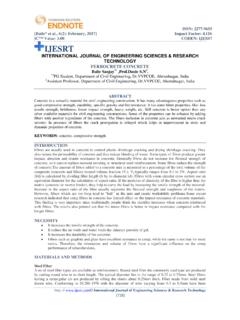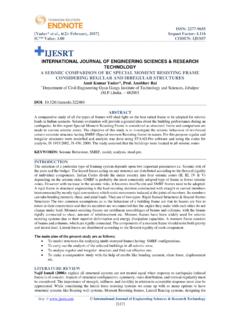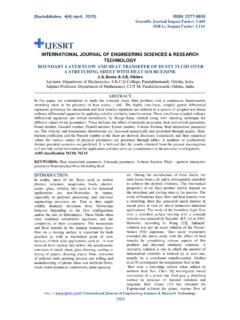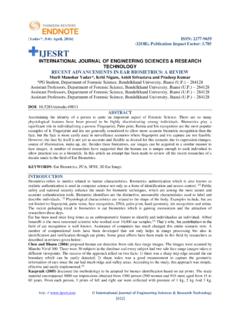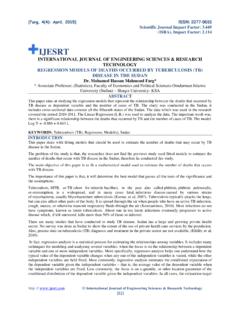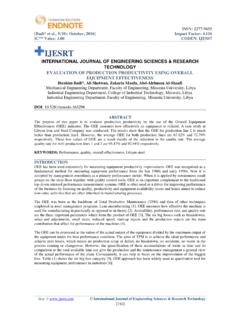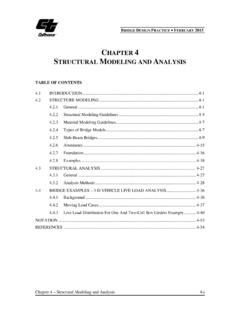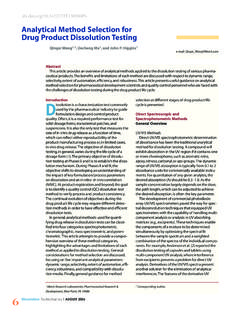Transcription of ELIMINATING FOUR WAVE MIXING WITH DYNAMIC …
1 [Jain* et al., 5(6): June, 2016] ISSN: 2277-9655 IC Value: Impact Factor: http: // International Journal of Engineering Sciences & Research Technology [530] IJESRT INTERNATIONAL JOURNAL OF ENGINEERING SCIENCES & RESEARCH TECHNOLOGY ELIMINATING FOUR WAVE MIXING WITH DYNAMIC CHANNEL SHUFFLING IN DWDM OPTICAL NETWORK Alisha Jain*, Harpreet Kaur * Student, Deptt. of Electronics and Communication, BBSBEC,Fatehgarh Sahib, Punjab, India Assistant Professor, Deptt. of Electronics and Communication, BBSBEC, Fatehgarh Sahib , Punjab DOI: ABSTRACT Optical Fiber systems are major telecommunication base for worldwide broadband networks. The bandwidth capacity is increased by using DWDM optical networks. But in DWDM Optical Communication System, the nonlinear effects degrades the system performance.
2 FWM is a nonlinear effect that appears at very high optical power and dense channel spacing. When the channels are equally spaced in a DWDM system, the new waves will be generated by FWM and these new waves will drop at channel frequencies, giving rise to crosstalk. Four-wave MIXING (FWM) is a parametric approach in which distinct frequencies interact causing the generation of new spectral components. Coming generation optical networks insists on the use of the high input power and high bandwidth capacity to accomplish bigger data rates. However, enlarging input power and reducing channel spacing create nonlinear effects including Four Wave MIXING (FWM). So a technique using circular polarizers along with proposed algorithm namely DYNAMIC wavelength shuffling algorithm is implemented which results in reduction of FWM to a greater extent and results are formulated in terms of Q-factor, SNR and BER.
3 KEYWORDS: BER, Q-FACTOR, SNR, FWM. INTRODUCTIONO ptical fiber communication is a means of transferring information from one place to another by forwarding pulses of light via an optical fiber [2]. Wide bandwidth signal transmission with less delay is a important factor in present day applications. DWDM Optical fibers networks provide huge and incomparable transmission bandwidth with too small latency, and are now the transmission intermediate of choice for high data rate and long distance transmission in telecommunication networks. Numerous channels of information can travel over a single fiber each using an separate wavelength in Dense Wavelength Division Multiplexing (DWDM)[2]. But in Optical Communication System, the nonlinear effects degrades the system performance due to dense channel spacing. As nonlinear effects appears at very high optical power and dense channel spacing, they become important in DWDM.
4 Four Wave MIXING (FWM ) is one of the degradation effects in the WDM system with dense channel spacing. FWM is due to changes in the refractive index with optical power called optical Kerr effect[11][6][5]. Four-wave MIXING (FWM) is a parametric approach in which distinct frequencies interact causing the generation of new spectral components[3][9]. When the channels are equally spaced in a WDM system, the new waves generated by FWM coincides with channel frequencies giving rise to crosstalk[3][9]. The new frequencies generated by FWM drops into signal channels, which reduces the signal-to-noise ratio (SNR) and raises bit error rate (BER) of the system. Therefore, mitigating FWM effects in the DWDM is very important [4]. So a technique including circular polarizers is used which changes the polarization of input pulses and converts it into left and right handed polarized pulses before multiplexer which results in reduction of FWM to a greater extent [1].
5 But this polarization effect is only applicable to default nature of optical communication. This means that number of users accessing optical links with circular polarization is quite low when compared to real time optical network traffic is concerned. This concern is real problem when we used optical communication for general purposes and peak hour of [Jain* et al., 5(6): June, 2016] ISSN: 2277-9655 IC Value: Impact Factor: http: // International Journal of Engineering Sciences & Research Technology [531] traffic reached. Our proposed solution will sort this issue with introduction of dynamically channel shuffling algorithm. In this research, the avoidance of congestion in Wavelength division multiplexing optical networks is done by developing wavelength shuffling algorithm scheme in OPNET Simulator.
6 Execution measure are done on the basis of parameters, for example, Bit error rate, Quality element and SNR. Thus, the paper presents the elimination of FWM in DWDM optical networks by using the proposed algorithm taking into account all the parameters. SIMULATION SET UP All the simulations are performed in Opnet at a bit rate of 1 Gbps with sequence length of 128 bits. The experimental values of our optical communication system consists of WDM transmitter containing 12 channels at a spacing of 200 GHz each .Channel frequencies are from 193 THz to RZ and NRZ modulation is used in transmitters followed by WDM multiplexer. MUX is connected to a Dispersion Compensating Fiber (DCF) having area of 80 m2 and 100 km length having dispersion of 80 ps/nm/km and dispersion slope of 0:075 ps/nm2/km with attenuation of 0:2 dB/km. DCF is followed by Erbium Doped Fiber Amplifier (EDFA) of 10 dB gain with zero noise figure.
7 On the receiver side, theiris a DEMUX followed by the optical receiver with cutoff frequency greater than Hz. Employing Circular Polarizers Circular polarizers alter the azimuthal polarization of arriving pulses into -90 degree and +90 degrees irregardless it is polarized left or right handly. Azimuthal polarization is the technique in which the polarization vector is tangential to the shaft of light. In this way the electric field of adjoining pulses is at 180 degree of each other so the interaction of neighbouring pulses is less which therefore leads in the minimization of FWM [1]. The circular polarizers have been used in the optical communication network The transmitter is attached to circular polarizers alternatively having right as well as left hand polarization , if first channel is fixed to left hand circular polarizer then second channel is fixed to right hand polarizer, and so on.
8 Circular polarizers are provided to the MUX which is connected to DCF [1]. Employing DYNAMIC Channel Shuffling Algorithm There is need of huge resources for fulfilling the rapidly increasing requirement of the communication. Optical fiber network contributes such as big amount of bandwidth with less delay and drop, so can be used for fulfilling increasing main focus is on implementing a good solution for DYNAMIC changing conversion algorithm which provides routing according to the resources available in the whole network. Proposed work processed the algorithm in pair wise distribution of wavelength assignment and has sorted the availability of frequencies on which communication need to process. This has sorted the issue of blocking or conversion of wavelength on intermediate nodes of optical network which directly lead to better flow and congestion avoidance[10].
9 Furthermore, wavelength converters are expensive [8][12].So we generate a new mechanism of frequency coverage but finding the aggregate value of paired paths with equal frequency matching. In this process we select the best two paths at initial stage after processing frequency matching algorithm in related study and then apply, aggregated scheme which will possibly shuffle the path if required for particular wavelength. Algorithm: The proposed algorithm is evolved to decrease the cost factor and to enhance the performance of the optical fibre network[7]. The algorithm is given below:- 1. Firstly find the routes having one or more free wavelengths from source node and list them. 2. Choose first two routes R1 and R2 from the list undergoing minimum frequency conversion and put RP R1 and Rs R2. 3. Send the request RQ on R1 and R2 with the information about destination, route, wavelength status for outgoing route, route cost, route time and load per link.
10 4. Check if the next node is not the destination node , if not then { [Jain* et al., 5(6): June, 2016] ISSN: 2277-9655 IC Value: Impact Factor: http: // International Journal of Engineering Sciences & Research Technology [532] i. Collect the request RQ and check out the information on signal. ii. Make a List of all the free wavelengths on route to the next node. iii. If no free wavelength is there, then RQ fails otherwise compare the wavelength of RQ with the available wavelengths. If wavelength matches then XR is not required and select that wavelength otherwise XR will be required iv. Add on RQ the information about the need of XR, Load as well as wavelength status of outgoing route. v.}
